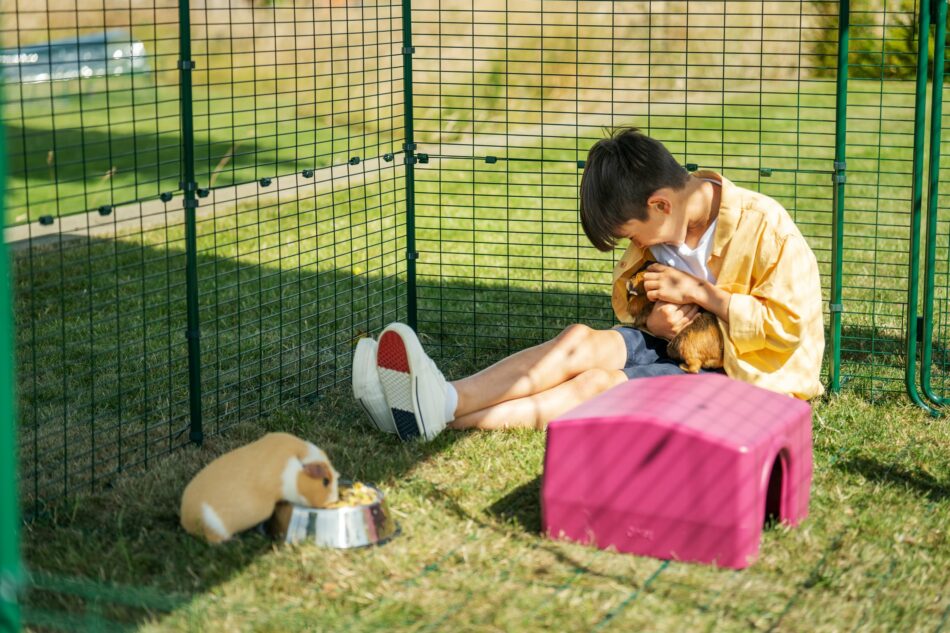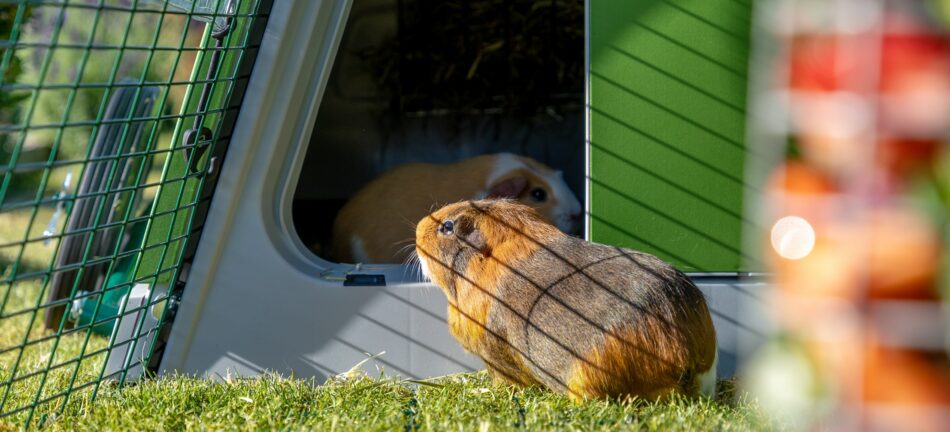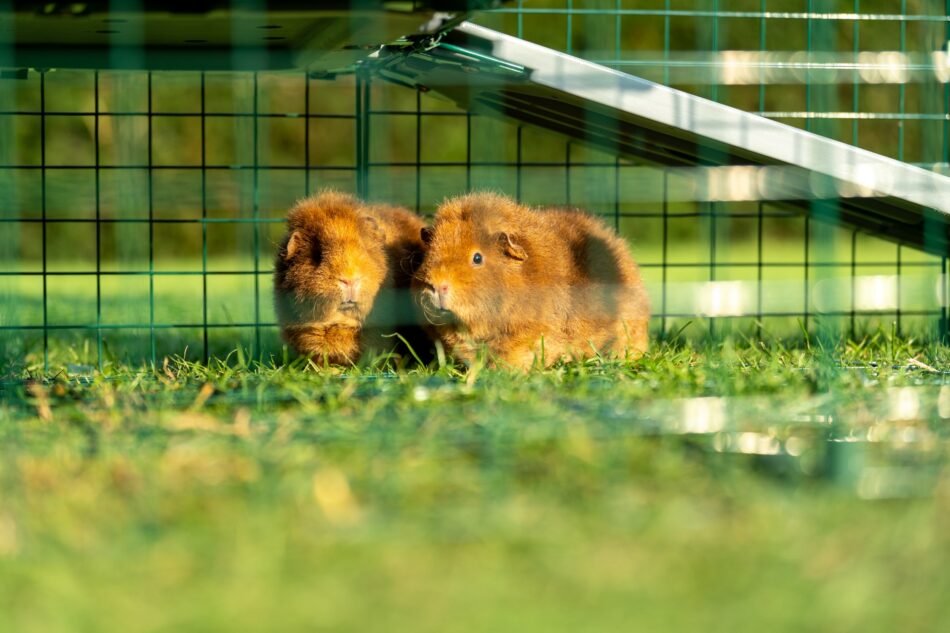Getting a guinea pig? Here’s everything you need
If you’re considering getting a guinea pig, you’re in good company. Guinea pigs (also known as “cavies”) are fun, quirky companions for people of all ages. Though small, these little animals make great pets that are full of character and personality. They’ll happily greet you with a series of adorable noises, affectionately nuzzle you during cuddling sessions, and provide you with hours of entertainment through their various eating and play habits. If you’ve ever owned a guinea pig, you know firsthand how enjoyable and rewarding it can be to have a guinea pig in your family. But, if this is your first time owning a guinea pig, here’s a checklist of everything you need.
A friend for your guinea pig
In the wild, guinea pigs live in groups called “herds”. They’re very social by nature and do best when they have a friend or two. Often guinea pigs will establish bonded pairings, but sometimes a group of 3 can be inseparable. A lone guinea pig will become depressed quickly, so be sure to plan on keeping at least 2 guinea pigs from the start.
Same-sex siblings are often a desirable pairing. Other same-sex pairings may also be successful, but you’ll want to introduce them slowly before housing them together. Be sure to only keep neutered males with females — otherwise, you’ll end up with accidental guinea pig pups. The idea of baby guinea pigs may sound cute, but behind the cuteness is a lot of extra care and having to separate males from females when they’re old enough to be weaned. And, unless you’ve got a lot of space or multiple setups, you’ll also need to find homes for the pups.
A cozy cavy hutch
Your guinea pigs will need a hutch to live in, even if you intend to keep them in your home. Whether you opt for a modern hutch like our Eglu Go guinea pig hutch or an indoor hutch option, you’ll need to weigh your decision carefully.
A good hutch is vital to a guinea pigs’ wellbeing. It’s their home, and where they’ll spend the majority of their time. Well-made hutches provide a secure environment for your guinea pigs to sleep, socialize, and exercise, and it will last you and your pets many years. And, by investing in a high-quality hutch, you won’t have to worry about maintenance or replacements.
The Eglu Go hutch can comfortably house 2-3 guinea pigs, and is the easiest cavy home you’ll ever have the pleasure of cleaning. Our unique design encourages your guinea pigs to express their natural behaviors, making them feel right at home from the beginning. And, with twin-insulated walls, your cavy will stay comfortable in any season.
It’s a common misconception that guinea pigs can’t be housed outdoors year-round. When they’re provided with quality shelter and space, they adapt well in natural settings. Special care should be taken during extreme weather conditions and temperatures, but guinea pigs can live outdoors safely the majority of the year in a setup like the Eglu Go guinea pig hutch.
It’s important to note that guinea pigs should be brought inside when temperatures are consistently above 80 degrees or below 50 degrees. Unless you’re able to check on them every couple of hours during temperature dips or spikes, it’s best to bring them in a temperature-controlled environment.
Space to exercise and play
Like most pets, guinea pigs thrive when they have as much space as possible. It’s especially important for guinea pigs to have room to exercise, as they are prone to obesity. Their little legs are adorable, but struggle under extra weight. The attached run of the Eglu Go guinea pig hutch offers your cavy room to run and play, but you can give them even more space by adding Zippi Guinea Pig Runs and Playpens.
The Zippi Guinea Pig Tunnel System brings all of this together by creating a route between their hutch and playpen. In the wild, guinea pigs seek shelter in burrows or tunnels constructed by other animals. They’re constantly on the lookout for potential threats, so providing hideouts and tunnels appeals to their desire to seek shelter. And, with convenient attachment kits, the Zippi guinea pig tunnel system can be connected to wooden hutches or any wire run easily.
For additional exercise, Zippi Guinea Pig Platforms can be installed inside of our playpens. The ramp is specially designed for little cavy legs, and the safety rails help prevent accidental tumbles. Zippi platforms are a great way to utilize aerial space, and to help you interact with your guinea pig on a whole new level — literally.
A quality diet and fresh water
Guinea pigs should have free-choice access to quality pellets and fresh water at all times. Their feed should consist of timothy hay-based pellets, rather than the “trail mix” variety of food. When offered this mix, cavies will pick out their favorite bits and leave the more nutritious pieces behind. Since guinea pigs can become overweight easily, it’s important to only feed them foods that offer nutritional value and not empty calories.
Cavies are in the rodent family, and as such, their teeth continuously grow. To combat this, make sure they have access to loose timothy hay at all times. In the wild, guinea pigs graze on grasses and plants all day long to help keep their teeth trimmed and their bellies in working order. In addition to their hay, offer your guinea pigs fresh herbs, leafy greens, and guinea pig-safe vegetables in moderation to round out their diet. As an occasional treat, you can serve your guinea pigs small pieces of fresh fruit.
Vitamin C
Guinea pigs are among a small group of mammals that can’t make their own vitamin C. Like humans, they need their daily dose of this essential vitamin in order to stay healthy. Most commercially made guinea pig pellets have vitamin C added, but be sure to check labels.
There are multiple other ways to make sure your guinea pigs are getting enough vitamin C. These include:
- Store-bought vitamin C drops to add to their water
- Offer vitamin C-rich veggies like broccoli, bell pepper, or dark leafy greens
- During playtime, reward your cavy with vitamin C-rich fruits like strawberries
A predictable routine
Guinea pigs will find comfort in their daily routine and soon come to expect their meals, playtime, and bedtime. They’ll also quickly learn that you are the bringer of food, playtime coordinator, and provider of safety — and will reward you with friendly squeaks and other noises from guinea pig vernacular.
Plan to check in on your guinea pigs at least once a day, but the more you interact with themes, the better your bond will be. Your cavies will soon anticipate your visits and will be more active when you spend time with them.
Omlet has all your guinea pig needs
We’ve designed comfortable cavy homes that keep your guinea pigs safe while making caring for them easier than ever for you. Our Eglu Go guinea pig hutch, Zippi Guinea Pig Tunnel System, and Zippi Guinea Pig Runs and Playpens are instant housing and enrichment solutions for cavy keepers of all ages and experience levels. With Omlet, you’ll be able to start keeping guinea pigs with success from the beginning.
This entry was posted in Guinea Pigs



